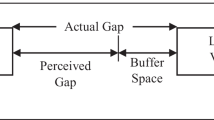Abstract
In this paper, the spatiotemporal process of lane changing is considered in the cellular automaton models for traffic flow. The lane-changing time and the space required depend on the instantaneous velocity of the vehicle and following vehicle in the destination lane. The simulation is carried out in a two-lane homogeneous system. The speed change of the lane changing vehicle accords with the fundamental diagram and a 2D region is found in the lane changing frequency-velocity plane.
Access this chapter
Tax calculation will be finalised at checkout
Purchases are for personal use only
Preview
Unable to display preview. Download preview PDF.
Similar content being viewed by others
References
Zheng, Z.: Recent developments and research needs in modeling lane changing. J. Transportation Research Part B: Methodological 60, 16–32 (2014)
Toledo, T., Zohar, D.: Modeling duration of lane changes. Transportation Research Record, 71–78 (2007)
Cao, X., Young, W., et al.: Exploring Duration of Lane Change Execution. 36th Australasian Transport Research Forum (ATRF), Brisbane, Queensland, Australia (2013)
Chowdhury, D., Wolf, D.E., Schreckenberg, M.: Particle hopping models for two-lane traffic with two kinds of vehicles: Effects of lane-changing rules. Physica A: Statistical Mechanics and its Applications 235(3), 417–439 (1997)
Jia, B., Jiang, R., et al.: Honk effect in the two-lane cellular automaton model for traffic flow. Physica A: Statistical Mechanics and its Applications 348, 544–552 (2005)
Li, X.-G., Jia, B., Jiang, R.: The Effect of Lane-Changing Time on the Dynamics of Traffic Flow. In: Zhou, J. (ed.) Complex 2009, Part I. LNICST, vol. 4, pp. 589–598. Springer, Heidelberg (2009)
Nagel, K., Schreckenberg, M.: A cellular automaton model for freeway traffic. J. Phys. I France 2, 2221–2229 (1992)
Author information
Authors and Affiliations
Editor information
Editors and Affiliations
Rights and permissions
Copyright information
© 2014 Springer International Publishing Switzerland
About this paper
Cite this paper
Li, Hx., Shao, Cf., Wu, Hl., Tian, Jf., Ji, X. (2014). A New Cellular Automaton Model with Spatiotemporal Process of Lane Changing Execution. In: Wąs, J., Sirakoulis, G.C., Bandini, S. (eds) Cellular Automata. ACRI 2014. Lecture Notes in Computer Science, vol 8751. Springer, Cham. https://doi.org/10.1007/978-3-319-11520-7_64
Download citation
DOI: https://doi.org/10.1007/978-3-319-11520-7_64
Publisher Name: Springer, Cham
Print ISBN: 978-3-319-11519-1
Online ISBN: 978-3-319-11520-7
eBook Packages: Computer ScienceComputer Science (R0)




